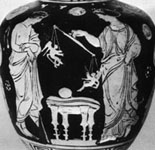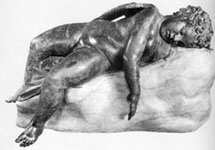Eros (Roman Cupid - Italian putto)



Child of
Aphrodite, and her assistant in promoting love matches among gods and mortals. He is shown as a winged youth, becoming a baby after the 4th century BC, and his weapon is the bow, or sometimes a whip. Otherwise he appears with ordinary youthful attributes - a hare, hoop. He is sometimes shown in art at mortal occasions such as marriages, and regularly with
Aphrodite. On his own he represents the power of sexual attraction. In later art the figure is often multiplied, and two erotes may be weighed against each other by a woman in a love ritual, shown (as here at middle image) on some classical vases (Erotostasia). He is often indistinguishable from
Pothos or Himeros who personify similar emotions (yearning desire).
Above left: Detail from an Athenian white-ground clay vase, about 490 BC. Cleveland, Museum of Art 66.114. © Museum of Art, Cleveland
Above middle: Detail from a South Italian red-figure clay vase, about 350 BC. London. British Museum F220 © British Museum
Above right: Bronze. New York Metropolitan Museum of Art 43.11.4. Rogers Fund. Photo. Museum 131094 B LS © Metropolitan Museum of Art


